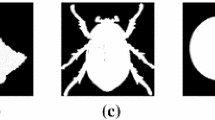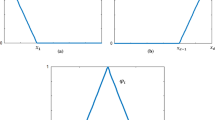Abstract
Two novel algorithms for the fast computation of the Zernike and Pseudo-Zernike moments are presented in this paper. The proposed algorithms are very useful, particularly in the case of using the computed moments, as discriminative features in pattern classification applications, where the computation of single moments of several orders is required. The derivation of the algorithms is based on the elimination of the factorial computations, by computing recursively the fractional terms of the orthogonal polynomials being used. The newly introduced algorithms are compared to the direct methods, which are the only methods that permit the computation of single moments of any order. The computational complexity of the proposed method is O(p 2) in multiplications, with p being the moment order, while the corresponding complexity of the direct method is O(p 3). Appropriate experiments justify the superiority of the proposed recursive algorithms over the direct ones, establishing them as alternative to the original algorithms, for the fast computation of the Zernike and Pseudo-Zernike moments.
Similar content being viewed by others
References
R. Mukundan and K. R. Ramakrishnan, Moment Functions in Image Analysis (World Sci. Publ., 1998).
K. Tsirikolias and B. G. Mertizos, “Statistical Pattern Recognition Using Efficient 2-D Moments with Applications to Character Recognition,” Pattern Recognition 26, No. 6, 877–882 (1993).
B. G. Mertzios and K. Tsirikolias, “Statistical Shape Discrimination and Clustering Using an Efficient Set of Moments,” Pattern Recognition Lett. 14, 517–522 (June 1993).
B. G. Mertzios, “Shape Discrimination in Robotic Vision Using Scaled Normalized Central Moments,” in Proc. IFAC Workshop on Mutual Impact of Computing Power and Control Theory (Prague, Sept. 1–2 1992), pp. 281–287.
A. Khotanzad and J.-H. Lu, “Classification of Invariant Image Representations Using a Neural Network,” IEEE Trans. on Acoustics, Speech and Sign. Processing ASSP-38, No. 6, 1028–1038 (1990).
G. A. Papakostas, Y. S. Boutalis, D. A. Karras, and B. G. Mertzios, “A New Class of Zernike Moments for Computer Vision Applications,” Information Sci. 177, No. 13, 2802–2819 (2007).
G. A. Papakostas, D. A. Karras, B. G. Mertzios, and Y. S. Boutalis, “An Efficient Feature Extraction Methology for Computer Vision Applications Using Wavelet Compressed Zernike Moments,” ICGST Int. J. on Graphics, Vision and Image Processing, Special Issue: Wavelets and Their Applications SI1, 5–15 (2005).
C. Kan and M. D. Srinath, “Invariant Character Recognition with Zernike and Orthogonal Fourie-Mellin Moments,” Pattern Recognition 35(1), 143–154 (2002).
C. W. Chong, P. Raveendran, and R. Mukundan, “A Comparative Analysis of Algorithms for Fast Computation of Zernike Moments,” Pattern Recognition 36(3), 731–742 (2003).
S. O. Belkasim, M. Ahmadi, and M. Shridhar, “Efficient Algorithm for Fast Computation of Zernike Moments,” J. Franklin Inst. 333(B)(4), 577–581 (1996).
J. Gu, H. Z. Shu, C. Toumoulin, and L. M. Luo, “A Novel Algorithm for Fast Computation of Zernike Moments,” Pattern Recognition 35(12), 2905–2911 (2002).
A. Prata and W. V. T. Rusch, “Algorithm for Computation of Zernike Polynomials Expansion Coefficients,” Appl. Opt. 28, 749–754 (1989).
E. C. Kintner, “On the Mathematical Properties of the Zernike Polynomials,” Opt. Acta 23(8), 679–680 (1976).
Chong Chee-Way, R. Mucundan, and P. Raveendran, “An Efficient Algorithm for Fast Computation of Pseudo-Zernike Moments,” in Proc. Int. Conf. on Image and Vision Computing (IVVCNZ’01) (Dunedin, 2001), pp. 237–242.
C. N. Papaodysseus, E. B. Koukoutsis, and C. N. Triantafyllou, “Error Sources and Error Propagation in the Levinson-Durbin Algorithm,” IEEE Trans. Signal Processing SP-41(4) (April 1993).
C. N. Papaodysseus, G. Carayannis, E. B. Koukoutsis, and E. Kayafas, “Comparing LS FIR Filtering and 1-Step Ahead Linear Prediction,” IEEE Trans. Signal Processing SP-41, No. 2 (Feb. 1993).
C. Papaodysseus, E. Koukoutsis, and C. Vassilatos, “Error Propagation and Methods of Error Correction in LS FIR,” IEEE Trans. Signal Processing SP-42, No. 5 (May 1994).
T. W. Lin and Y. F. Chou, “A Comparative Study of Zernike Moments for Image Retrieval,” in Proc. 16th IPPR Conf. on Computer Vision, Graphics and Image Processing (CVGIP 2003) (Taiwan, 2003), pp. 621–629.
M. Zhenjiang, “Zernike Moment-Based Image Shape Analysis and its Application,” Pattern Recognition Lett. 21(2), 169–177 (2000).
D. G. Sim, H. K. Kim, and R. H. Park, “Invariant Texture Retrieval Using Modified Zernike Moments,” Image and Vision Comp. 22(4), 331–342 (2004).
M. Teague, “Image Analysis via the General Theory of Moments,” J. Opt. Soc. Amer. 70(8), 920–930 (1980).
F. Zernike, “Beugunstheorie des Schneidenverfahrens und seiner verbesserten Form, der Phasenkonstrastmethode,” Physica 1, 689–701 (1934).
J. Haddadnia, M. Ahmadi, and K. Faez, “An Efficient Feature Extraction Method with Pseudo-Zernike Moment in RBF Neural Network-Based Human Face Recognition System,” EURASIP J. on Applied Signal Processing 9, 890–901 (2003).
J. Haddadnia, K. Faez, and M. Ahmadi, “A Neural Based Human Face Recognition System Using an Efficient Feature Extraction Method with Pseudo Zernike Moment,” J. Circuits, Systems, and Computers 11(3), 283–304 (2002).
C.-H. The and R. T. Chin, “On Image Analysis by the Methods of Moments,” IEEE Trans. on Pattern Anal. Machine Intell. PAMI-10, No. 4, 496–513 (1988).
G. A. Papakostas, Y. S. Boutalis, and B. G. Mertzios, “Evolutionary Selection of Zernike Moment Sets in Image Processing,” in Proc. 10th Intern. Workshop on Systems, Signals and Image Processing (IWSSIP’03) (Prague, Sept. 10–11 2003).
G. A. Papakostas, Y. S. Boutalis, C. N. Papaodysseus, and D. K. Fragoulis, “Numerical Error Analysis in Zernike Moments Computation,” Image and Vision Comp. 24, 960–969 (2006).
Author information
Authors and Affiliations
Corresponding author
Additional information
The article is published in the original.
George A. Papakostas received the diploma of Electrical and Computer in Engineering in 1999 and the Msc. and PhD. Degree in Electrical and Computer Engineering (topic in Feature Extraction and Pattern Recognition) in 2002 and 2007 respectively, from Democritus University of Thrace (DUTH), Greece. He is the author of thirty publications in international scientific journals and conferences. He research interests are focused on the field of pattern recognition, neural networks, feature extraction, optimization, signal and image processing. Dr. Papakostas served as reviewer in numerous scientific journals and conferences and his is member of Technical Chamber of Greece.
Yiannis S. Boutalis received the diploma of Electrical Engineer in 1983 from the Democritus University of Thrace (DUTH), Greece and the PhD degree in Electrical and Computer Engineering (topic Image Processing) in 1988 from the Computer Science Division of National Technical University of Athens, Greece. Since 1996, he serves as a faculty member, at the Department of Electrical and Computer Engineering, DUTH, Greece, where he is currently an Associate Professor and director of the automatic control systems lab. Currently, he is also a Visiting Professor for research cooperation at Erlangen-Nuremberg University of Germany, chair of Automatic Control. He served as an assistant visiting professor at University of Thessaly, Greece, and as a visiting professor in Air Defence Academy of General Staff of airforces of Greece. He also served as a researcher in the Institute of Language and Speech Processing (ILSP), Greece, and as a managing director of the R&D SME Ideatech S.A, Greece, specializing in pattern recognition and signal processing applications. His current research interests are focused in the development of Computational Intelligence techniques with applications in Control, Pattern Recognition, Signal and Image Processing Problems.
Dimitrios A. Karras received his Diploma and M.Sc. Degree in Electrical and Electronic Engineering from the National Technical University of Athens, Greece in 1985 and the Ph. Degree in Electrical Engineering, from the National Technical University of Athens, Greece in 1995, with honors. In 1990 he received, also, his Diploma Degree in Mathematics from the University of Athens. Since 2004, after his election, he has been with the Chalkis Institute of Technology, Automation Dept., Greece as full professor in Digital Systems as well as with the Hellenic Open University, Dept. Informatics as a visiting professor. He has published more than 40 research Journal papers in various areas of pattern recognition, image/signal processing and neural networks and more than 80 research papers in International Scientific Conferences. His research interests span the fields of pattern recognition and neural networks, multidimensional digital signal processing, image processing and analysis, communications and security, as well as parallel algorithms and fast processing.
Basil G. Mertzios was born in Kavala, Greece on August 10, 1956. He received the Diploma Degree in Electrical and Mechanical Engineering from the Aristotle University of Thessaloniki, Greece in 1979 and the Ph. Degree in Electrical Engineering, from the Democritus University of Thrace, Greece in 1982, both with honors. Part of his Ph. D. work has been done in University of Toronto. From 1986–1992 he was an Associate Professor at the Democritus University of Thrace, Department of Electrical Engineering and Director of the Laboratory of Automatic Control Systems and from 1992 a Professor at the same University. Also he has been invited and served as Professor of Control Systems and Computational Intelligence at the Department of Automation of the Technological Institute of Thessaloniki. During various periods since 1983, he visited extensively University of Toronto and Ruhr-Universitat Bochum, Germany as a research fellow. During part of 1986 he visited Georgia Institute of Technology, Atlanta, U.S.A., as an Adjunct Associate Professor. The academic year 1987–1988 he was a Visiting Associate Professor at Georgia Institute of Technology, School of Electrical Engineering, in Fall Semester of 1991 he was a Visiting Professor at the University of Toronto and in 1996 he was a Visiting Professor at the Tokyo Institute of Technology, Japan. He was awarded in 1986 the Senior Fulbright Research Award, in 1987 the Alexander von Humboldt Fellowship and in 1988 the Natural Sciences and Engineering Research Council of Canada International Scientific Exchange Award. He published more than 100 research Journal papers in various areas of control system theory, multidimensional digital signal processing and robotics and more than 140 research papers in International Scientific Conferences. His research interests span the fields of automatic control systems, parallel algorithms and fast processing, robotics, multidimensional digital signal processing, image processing and analysis, pattern recognition and neural networks.
Rights and permissions
About this article
Cite this article
Papakostas, G.A., Boutalis, Y.S., Karras, D.A. et al. Efficient computation of Zernike and Pseudo-Zernike moments for pattern classification applications. Pattern Recognit. Image Anal. 20, 56–64 (2010). https://doi.org/10.1134/S1054661810010050
Received:
Published:
Issue Date:
DOI: https://doi.org/10.1134/S1054661810010050




